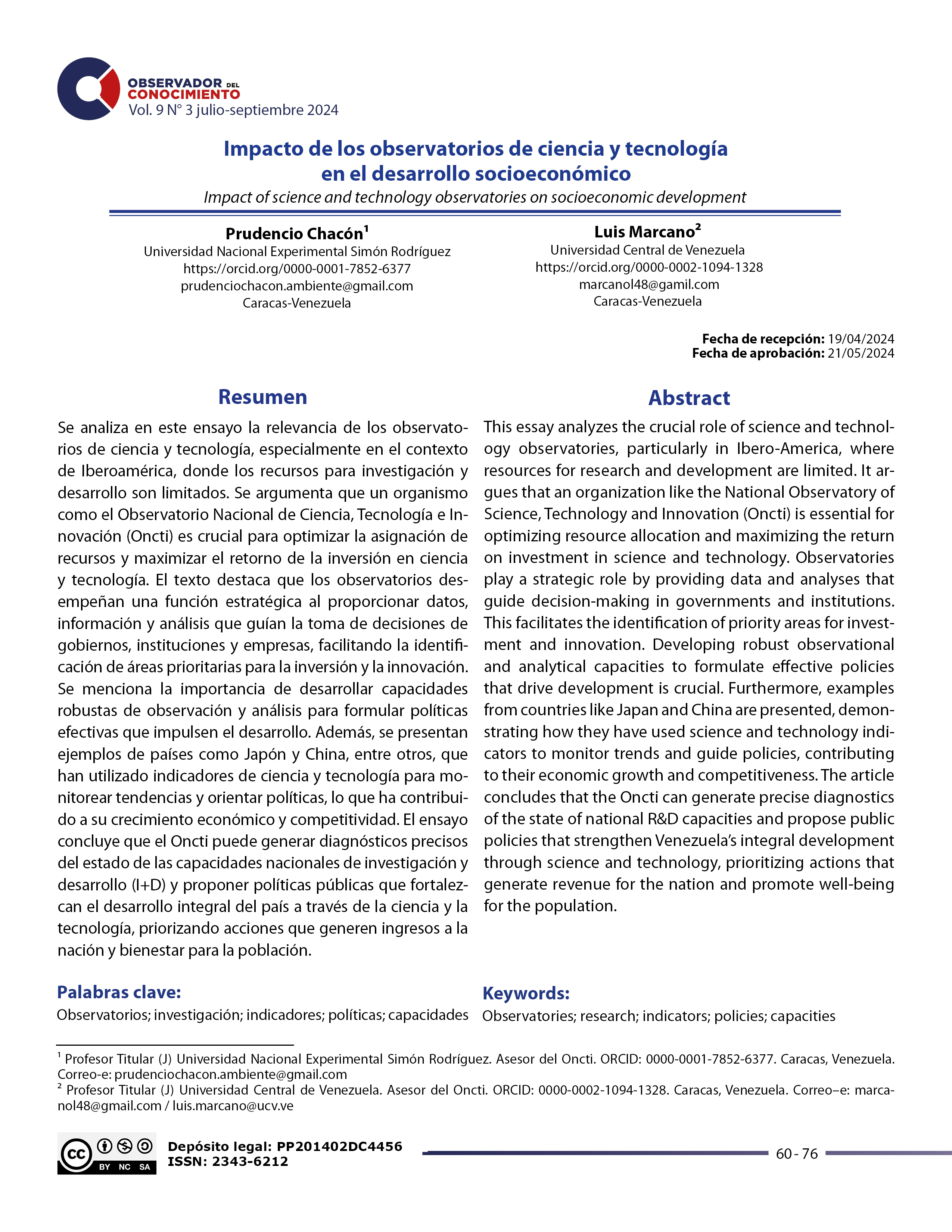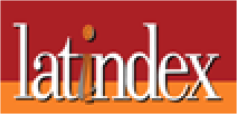Impact of science and technology observatories on socioeconomic development
Keywords:
Observatories, research, indicators, policies, capacitiesAbstract
This essay analyzes the crucial role of science and technology observatories, particularly in Ibero-America, where resources for research and development are limited. It argues that an organization like the National Observatory of Science, Technology and Innovation (Oncti) is essential for optimizing resource allocation and maximizing the returnon investment in science and technology. Observatories play a strategic role by providing data and analyses that guide decision-making in governments and institutions.
This facilitates the identification of priority areas for investment and innovation. Developing robust observational and analytical capacities to formulate effective policies that drive development is crucial. Furthermore, examples from countries like Japan and China are presented, demonstrating how they have used science and technology indicators to monitor trends and guide policies, contributing to their economic growth and competitiveness. The article concludes that the Oncti can generate precise diagnostics
of the state of national R&D capacities and propose public policies that strengthen Venezuela’s integral development
through science and technology, prioritizing actions that generate revenue for the nation and promote well-being for the population
Downloads
References
Akhondzadeh, S. (2017). Innovation and Technology in Iran. Avicenna Journal of Medical Biotechnology, 9(3), 113. Dis
ponible en: https://www.ncbi.nlm.nih.gov/pmc/articles/PMC5501136/ Bhalla, A. S., & Fluitman, A. G. (1985). Science and Technology Indicators and Socio-economic Development. En Science and Technology Indicators for Development (1st ed., pp. 25). Routledge. Disponible en: https://doi.
org/10.4324/9780429305436 Bybee, R. W. (2010). What Is STEM Education? Science, 329(5995), 996. Disponible en: https://doi.org/10.1126/ science.1194998 Cambridge Science Park. Cambridge Science Park. Disponi
ble en https://www.cambridgesciencepark.co.uk/ Cuéllar Escobar, J. (2011). La articulación estado-empresa para el desarrollo de la competitividad empresarial-análisis descriptivo del caso coreano. Documentos de investigación. Administración de Empresas, N° 7. Bogotá: Ediciones Universidad Central. Disponible en https://papers.ssrn.
com/sol3/Delivery.cfm/SSRN_ID2016604_code1798493. pdf?abstractid=2016604&mirid=1 De la Vega, I. (2007). Tipología de Observatorios de Ciencia y Tecnología: Los casos de América Latina y Europa. Revista Española de Documentación Científica, 30(4), 545-552. ISSN 0210-0614. https://redc.revistas.csic.es/index.php/redc/arti
cle/view/404/416 Expansión/datosmacro.com (s/f). Disponible en:
https://datosmacro.expansion.com/comercio/exportaciones/Venezuela Fagerberg, J. (2006). What do we know about innovation and socio-economic change? Lessons from the TEARI Project. In L. Earl & F. Gault (Eds.), National innovation, indicators and policy (pp. 19-33). Edward Elgar Publishing. Disponible en:
https://doi.org/10.4337/9781847201645.00013 International Association of Science Parks and Areas of In
novation. (s.f.) Hoa Lac Hi-Tech Park Management Board. Disponible en: https://www.iasp.ws/our-members/direc
tory/@6295/hoa-lac-hi-tech-park-management-board.
Klingler-Vidra, R. y Wade, R. (2019). Science and Technology Policies and the Middle-Income Trap: Lessons from Vietnam. The Journal of Development Studies, 56(4), 717–731. Disponible en: https://doi.org/10.1080/00220388.2019.1595598
König, M., & Ploier, F. (2020). Shenzhen and its comparison to the Silicon Valley. Disponible en: https://free-and-open-technologies.github.io/papers/K%C3%B6nig_and_Ploier_ Shenzhen_and_its_comparison_to_the_Silicon_Valley_
(2020).pdf
Lemus, D. (2020). Vietnam: políticas públicas en ciencia, tecnología e innovación. Estudios de Asia y África, 55(2), 263
Disponible en: https://doi.org/10.24201/eaa.v55i2.2454
Lozano Teruel, J. A. (1990, November 18). Tsukuba, ciudad de la ciencia. El País. Disponible en: https://cienciaysalud.
laverdad.es/la-ciencia/ciencia-actual/tsukuba-ciudad-ciencia-article.html
Mahdi, R. (2015). Evaluation of National Science and Technology Policies in Iran. Procedia - Social and Behavioral Sciences, 195, 210-219. Disponible en: https://doi.org/10.1016/j.sbs
pro.2015.06.352 Marcial, N. A. (2009). ¿Qué son los observatorios y cuáles son sus funciones? Innovación educativa, 9(47), 5-17. Disponible en: https://www.redalyc.org/pdf/1794/179414895002.pdf
Mok, K., Welch, A., y Kang, Y. (2019). Government innovation policy and higher education: the case of Shenzhen, China. Journal of Higher Education Policy and Management, 42(2), 194–212.
https://doi.org/10.1080/1360080X.2019.1701851 Namdarian, L. (2017). Evaluation of science, technology, and
innovation (STI) in Iran. COLLNET Journal of Scientometrics and Information Management, 11(2), 253–271. Disponible
en: https://doi.org/10.1080/09737766.2017.1321728
National Institute of Science and Technology Policy (2022). Japanese Science and Technology Indicators 2022 (NISTEP RESEARCH MATERIAL No. 318). Disponible en: https://doi. org/10.15108/rm318e
Observatorio Nacional de Ciencia, Tecnología e Innovación (2023). Manual de Caracas: Guía para la recolección de datos de investigación y desarrollo en Venezuela (Primera edición). Ediciones ONCTI. Disponible en: https://www.oncti.gob.ve/ publicaciones
Ohayon, P., Barreiros, D., y Ghavami, K. (2014). Science and Technology Observatory for “NOCMAT” in Brazil: Role and proposed framework. Key Engineering Materials, 600, 399-412. https://
doi.org/10.4028/www.scientific.net/KEM.600.399 ONCTi (s.f.) Recuperado en https://www.oncti.gob.ve/nosotros/
Parque Tecnológico de São José dos Campos. Disponible en https://pitsjc.org.br.
Parc Scientifique de l’Université de Lille. Disponible en https://www.univ-lille.fr/
Pillsbury, M. (2005, April 21). China’s Progress in Technological Competitiveness: The Need for a New Assessment. U.S.,China Economic and Security Review Commission. Disponible en:
https://www.uscc.gov/sites/default/files/4.21-22.05pillsbury.pdf Ryu, S., y Kim, S. (2018). Investigation of Urban Places in Seoul Digital Industrial Complex (G-Valley). IOP Conference Series:
Earth and Environmental Science, 213(1), 012015. Disponible en: https://doi.org/10.1088/1755-1315/213/1/012015
Schmidt, N., y Silva, C. (2018). Observatório como instrumento de prospectiva estratégica para las Instituições de Ciência e Tecnologia (ICTs). Interações (Campo Grande), 19, 387-400. Disponible en: https://doi.org/10.20435/inter.v19i2.1689.
The Economic Times (2023). How emerging IT hub in Noida, Yamuna Expressway could challenge Gurgaon & Bengaluru tech supremacy. Disponible en https://economictimes. indiatimes.com/industry/services/property-/-cstruction/how-emerging-it-hub-in-noida-yamuna-expressway-could challenge-gurgaon-bengaluru-tech
supremacy/articles how/104182542.cms?from=mdr The Observatory of Economic Complexity -OEC – (s/f). Dis
ponible en: https://oec.world/es/profile/country/ven Yoon, J. (2014). Evolution of science and technology policy in
Korea. Journal of Policy Studies, 29(1), 147-172. Disponible en: https://jps.scholasticahq.com/article/35130.pdf

Downloads
Published
How to Cite
Issue
Section
License
Copyright (c) 2025 Prudencio Chacón, Luis Marcano

This work is licensed under a Creative Commons Attribution-NoDerivatives 4.0 International License.







